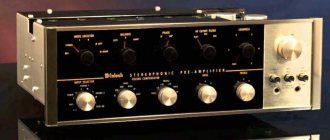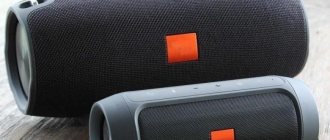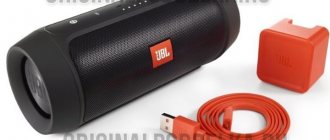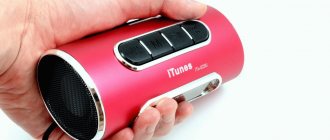There is an opinion that high-quality sound can only be obtained with the help of insanely expensive speaker systems, sometimes occupying an entire room. What about those who like to listen to music in high quality, but cannot afford such solutions?
The reasons can be different, from the high cost of acoustics, to the banal lack of space for their installation, or, for example, constantly indignant neighbors. In this case, good Hi-Fi headphones will help you. However, by connecting them directly to your smartphone or a regular MP3 player, you are unlikely to achieve the desired result. At a minimum, there is not enough output power to “boost” them, and the built-in DAC (digital-to-analog converter) in such devices is often “nothing.” So what should we do? Torment yourself with “dull” music or not listen to it at all? Not at all, and today we will talk about devices that will turn almost any sound source into a Hi-Fi class player .
The choice of such devices is quite large, but there are very few, if not almost non-existent, manufacturers whose devices produce truly high-quality sound at reasonable prices. And that is why the heroes of our review are the portable amplifiers DAC-HA200 and DAC-HA300 from the Japanese company Onkyo , one of the few that fall into this extremely narrow niche.
Onkyo DAC-HA200 Portable DAC/Amplifier
When you first approach the DAC-HA200, you don’t immediately understand what kind of “beast” is in front of you. The device resembles a transmitter for a radio microphone attached to the belt for guests of various TV shows. However, this opinion is more than erroneous, because in front of you is practically an entire audio studio in miniature , but first things first.
Appearance
The DAC-HA200 case is made of high-quality aluminum that is pleasant to the touch and has a rather unusual shape. This is due to the “horns” protruding on both sides of the device. Their purpose is quite obvious - to protect the switches and volume control from accidental presses. And given that the latter has a round shape, this is simply necessary.
On one side of the device there is a volume control, which also has a function to turn the device on/off, a high-power mode , a line input and a standard headphone jack. Both amplifier indicators are also located here.
On the other hand, there are USB and micro-USB ports for connecting sound sources, an amplifier operating mode switch, and a connector for charging the built-in battery.
Included with the amplifier you will find a charging cable and a wire for connecting to a computer. To connect the DAC-HA200 to an iPhone, you will have to use the standard Lightning cable included with every modern iOS smartphone.
We can’t help but mention two more “nanorubber bands” that come with every Onkyo portable amplifier. It's easy to guess that they are designed for attaching an amplifier to a sound source, for example, to an iPhone.
Connection
To use the DAC-HA200 with a Mac, you simply connect it with the included USB to micro USB cable, turn on the appropriate operating mode and select the required device in the system settings (in the “sound” menu):
It’s roughly the same on Windows devices: connect, switch and select:
To connect the DAC-HA200 to iOS devices, use a standard Lightning cable, and you can use Onkyo HF Player . The proprietary application does not have the most user-friendly interface and there are questions about displaying albums...
But there is one significant plus. It has a high-precision equalizer with the possibility of very fine tuning :
This feature is available for free , but only after you connect any Onkyo amplifier to your iOS device.
Capabilities
What the DAC-HA200 DAC/amplifier can do really inspires respect. The device not only has a high output power (up to 140 mW with a resistance of 32 Ohms), which allows you to significantly amplify the sound, but most importantly, it is equipped with a special chip responsible for converting digital code into an analog signal. This is the function of the DAC and the quality of the output sound largely depends on it. Even if you compare the sound of standard audio files downloaded from the iTunes store through the DAC-HA200 and without it, the differences are easy to notice. Sound detail increases significantly , and the low-frequency range sounds much more pleasant and “deeper”.
The DAC-HA200 portable amplifier can connect not only an iPhone, iPod or iPad, but also any AOA 2.0-compatible Android devices. And using the micro-USB connector, you can connect it to a PC or Mac.
It is worth paying tribute to the autonomy of the device. The built-in battery has a capacity of 2100 mAh, which allows for continuous operation of the device for 11 hours with an analog connection and 8 with a digital connection. Moreover, this indicator was confirmed in real conditions. When connecting the iPhone via Lightning (digital connection), the battery charge lasted for 7 hours and 45 minutes of continuous playback. This is a very good indicator for such devices. After all, saving energy is precisely one of the reasons why standard smartphones and MP3 players cannot “drive” serious high-impedance headphones. And with the DAC-HA200, we get high-quality sound for a long time .
Operating experience
The DAC-HA200 portable amplifier was tested using an iMac and iPhone 6, Bowers & Wilkins P5 Series 2 headphones and Apple EarPods. Just for fun, we even connected the DAC to ancient Sven speakers.
All subjects had one indicator, the values of which changed approximately the same - the level of maximum volume. It not only increased, but increased significantly ; in all cases, 2/3 of the maximum volume was enough. However, the matter did not stop there. The differences in sound with or without the DAC-HA200 were very significant across all devices. We have already written about increased sound detail and deeper sound in the low-frequency range, and this could be heard even in EarPods. The sound became more voluminous, and the expanded stereo panorama increased “immersion in the music.” There was a feeling that the sound had somehow “opened up”, become more alive , and previously unheard details forced us to rethink familiar compositions.
And how the sound of the high-end B&W P5 headphones has changed is a completely different story. Fans of deep and clear bass will be delighted; the DAC-HA200 has pumped them up to the fullest. The sound became completely different: a wider stage, bright and expressive highs. The only thing was that the mids were a little disappointing; it seemed to me that they were somehow “eclipsed” by the revealed lows and highs, but perhaps this was a matter of personal perception, or I couldn’t set the equalizer correctly. In any case, after I listened to the composition with an amplifier, I didn’t want to listen to it without it at all - it’s just NOT THE WAY!
Specifications
- impedance - 8 Ω–600 Ω (Line);
- maximum output power - 2 × 145 mW at 32 ohms, 2 × 60 mW at 300 ohms and 2 × 35 mW at 600 ohms;
- maximum linear output signal level - 1 Vrms;
- Sampling rate/depth 96 kHz/24-bit/5.6 MHz DSD;
- built-in battery capacity - 2100 mAh;
- battery life - up to 11 hours with an analog connection and up to 8 with a digital connection;
- dimensions (without protruding parts): 64 x 21.7 x 112 mm;
- weight: 210 g.
Main advantages:
- 1. The versatility of the device. 2. The ability to “pump up” serious headphones with high (up to 600 Ohms) impedance. 3. Long working time. 4. Competitive cost.
Flaws:
- 1. No indicator of remaining battery charge. 2. An absolutely inconvenient application, but with a very accurate equalizer.
Onkyo DAC-HA300 Portable DAC/Amplifier
Another hero of our review was a new product on the portable amplifier market - DAC-HA300 . The device is significantly different from its “younger brother” HA200, and this is not only due to its increased dimensions. The DAC-HA300 is a 3 in 1 device: amplifier, DAC and audio player. That is, in addition to all the cool functions that are available from the “younger brother,” the device can independently play music from microSD memory cards up to 128 GB. But first things first.
Appearance
The DAC-HA300's body is also made of aluminum and has a similar shape. But that's where all the similarities end. Firstly, it is equipped with OLED display, which displays all the necessary information.
Secondly, several additional buttons appeared for controlling the player, and the Gain high-power mode switch “moved” to the other side.
A microSD slot has also appeared, which is located on the same side with the Hold button and a wheel responsible for moving through the player menu.
The amplifier package is similar to the DAC-HA200, that is, you will certainly get “nanorubber bands”
Connection
The methods for connecting the DAC-HA300 to sound sources are not very different from the previously discussed device. The only thing is that there are only 2 modes - linear or digital. And when connected to a computer, the amplifier display shows information about the connection.
Capabilities
The capabilities of the amplifier/DAC/audio player DAC-HA300 will please even avid lovers of high-quality sound. Of course, because it can be connected to analog or digital sound sources in the MQS format (Mastering Quality Sound - 24 bit/192 kHz )! The HA300 delivers 2 x 170 mW output power into 32 ohms, and can also drive high impedance headphones (up to 600 ohms) at 2 x 40 mW. A 32-bit TI Burr-Brown PCM1795 chip is installed inside the device, and the amplification path is built on a MUSES8920 operational amplifier.
If we talk about the sensations experienced when listening to music through the DAC-HA300, then they were similar to the “200th”. The same high-quality and pleasant bass, the same “deep” and very detailed music . But I'm sure real audiophiles will feel the difference. It's worth just trying.
But in terms of autonomy, the DAC-HA300 loses to its younger brother. You have to pay for everything; increased power requires more energy. The device can work for 7 hours , and for a full charge it will take about 9 hours.
Player
Onkyo has bet that the main purpose of the new product will be to use it as a portable audio player. In our opinion, they made the right decision. Perhaps at first the player will seem inconvenient and ineffective to you, but this is not at all the case. The navigation is quite specific, but after half an hour of use you can easily get used to it and quickly find the desired composition.
Sorting by albums, artists and genres is supported, and playback of playlists recorded on the memory card is possible. The player can play Lossless files , for example, FLAC, of course, other formats are supported, including WAV, MP3, AAC, WMA, DSF, DFF (DSDIFF).
Specifications
- impedance - 8 Ω–600 Ω (Line);
- maximum output power - 2 × 170 mW at 32 ohms, 2 × 80 mW at 300 ohms and 2 × 40 mW at 600 ohms;
- maximum linear output signal level - 2 Vrms;
- Sampling rate/depth 192 kHz/24-bit/5.6 MHz DSD;
- battery life - up to 7 hours;
- dimensions (without protruding parts): 69.6 x 21.5 x 123 mm;
- weight: 280 g.
Main advantages of the device
- 1. Built-in audio player with support for most audio formats, including Lossless files. 2. High output power, allowing you to “pump” headphones with a resistance of up to 600 Ohms. 3. Supports memory cards up to 128 GB.
Flaws
- 1. Inconvenient application, with a cool equalizer. 2. Large dimensions.
Summing up the review of portable amplifiers DAC-HA200 and DAC-HA300 from the Japanese company Onkyo , it is worth noting that both devices will find their buyer. For those who value mobility, the DAC-HA300 is more suitable, since it has a built-in player and does not require additional cables. If the presence of an additional cable does not bother you, then the DAC-HA200 is suitable, but it is worth considering that its power is slightly weaker. One thing is for sure, after listening to music through these amplifiers at least once, listening to it without them will become unbearable. This is the other side of the coin. After testing these devices for a week, I still haven’t been able to bring myself to listen to music “the old fashioned way”; apparently, I’ll have to buy...
(
2 votes, overall rating: 4.50 out of 5)










